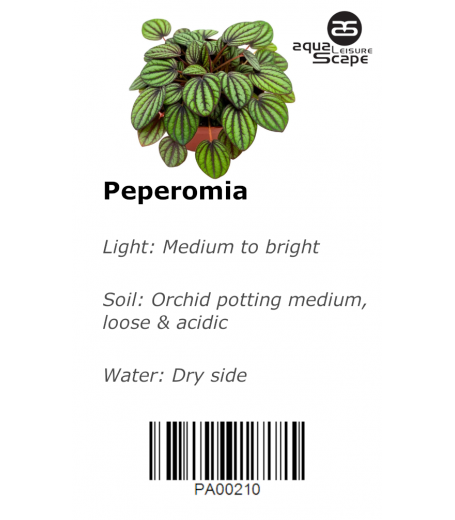PEPEROMIA
- RM25.00
Peperomia is a large genus of ornamental foliage tropical plants in the family Piperaceae native to Mexico, South America, and the Caribbean. With more than 1,500 known species, like watermelon peperomia and baby rubber plants, these hearty plants vary significantly in appearance.
Most boast thick, fleshy leaves that contribute to their drought tolerance and vigor. All Peperomia plants are low maintenance, slow-growing, and can be planted year-round. Plus, evidence shows they may remove toxins from the air.
| Common Names | Baby rubber plant, pepper elder, radiator plant, shining bush plant, emerald ripper pepper |
| Botanical Name | Peperomia spp. |
| Family | Piperaceae |
| Plant Type | Perennial |
| Mature Size | 6–12 in. tall, 6–12 in. wide |
| Sun Exposure | Full, partial |
| Soil Type | Moist but well-drained |
| Soil pH | Neutral, acidic |
| Bloom Time | Summer |
| Flower Color | White, green, brown |
| Hardiness Zones | 10–12 (USDA) |
| Native Area | Central America, South America, Caribbean |
Light
Position your Peperomia in a spot that receives medium to bright light to maintain its vibrant foliage colors. Place it directly in front of a west- or east-facing window, or set it a couple of feet back from a south- or north-facing window.
Insufficient light will result in fewer leaves, leaf drops, and drab coloration. Direct sun rays should be avoided, as they can burn the leaves.
Soil
Choose a soil blend that mimics chunky, loose, and acidic conditions. An orchid potting medium typically works well, but regular potting soil is fine, too. You can always lighten it with a handful of coconut coir and perlite for good aeration.
Many Peperomia species grow as epiphytes, which means in the wild, they might settle into the nook of a tree and send their roots into some slightly decaying bark.
Water
Allow the top two inches of the soil to dry out between waterings. Keeping Peperomia on the dry side is better than saturating it. Soggy soil can lead to root rot.2 Peperomia have succulent-like leaves that indicate that these plants don't need frequent watering to maintain vigor.
Temperature and Humidity
Give tropical Peperomia plants a warm and steamy environment, especially in the summer months when their growth is the most active.
If you're considering placing your Peperomia plants outdoors all year, make sure it's USDA zone 10, since they cannot handle freezing temperatures. In cooler areas, move plants indoors before nighttime temperatures drop to 50 degrees.
If your plant doesn't get an outdoor vacation in the summer, place it on a tray of pebbles and water to increase ambient humidity or keep it near a humidifier. Alternatively, choose a naturally humid room in the home, such as a bright bathroom for these humidity-loving plants.
Fertilizer
Provide a diluted liquid fertilizer once a month during the growing season if the soil is poor. When it comes to fertilizing Peperomia plants, less is more.
Do not fertilize in the winter. As a slow-growing epiphyte, Peperomia can go without supplemental fertilizer, getting what it needs from its planting media.
Reviews
There are no reviews for this product.



